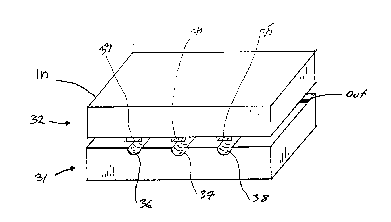Une partie des informations de ce site Web a été fournie par des sources externes. Le gouvernement du Canada n'assume aucune responsabilité concernant la précision, l'actualité ou la fiabilité des informations fournies par les sources externes. Les utilisateurs qui désirent employer cette information devraient consulter directement la source des informations. Le contenu fourni par les sources externes n'est pas assujetti aux exigences sur les langues officielles, la protection des renseignements personnels et l'accessibilité.
L'apparition de différences dans le texte et l'image des Revendications et de l'Abrégé dépend du moment auquel le document est publié. Les textes des Revendications et de l'Abrégé sont affichés :
| (12) Demande de brevet: | (11) CA 2095364 |
|---|---|
| (54) Titre français: | RESONATEUR |
| (54) Titre anglais: | RESONATOR STRUCTURE |
| Statut: | Réputée abandonnée et au-delà du délai pour le rétablissement - en attente de la réponse à l’avis de communication rejetée |
| (51) Classification internationale des brevets (CIB): |
|
|---|---|
| (72) Inventeurs : |
|
| (73) Titulaires : |
|
| (71) Demandeurs : |
|
| (74) Agent: | MARKS & CLERK |
| (74) Co-agent: | |
| (45) Délivré: | |
| (22) Date de dépôt: | 1993-04-22 |
| (41) Mise à la disponibilité du public: | 1993-11-09 |
| Licence disponible: | S.O. |
| Cédé au domaine public: | S.O. |
| (25) Langue des documents déposés: | Anglais |
| Traité de coopération en matière de brevets (PCT): | Non |
|---|
| (30) Données de priorité de la demande: | ||||||
|---|---|---|---|---|---|---|
|
The present invention relates to a resonator structure com-
posed of two dielectric pieces. On the upper surface of a
first piece (1) is provided a groove (7) extending across
the entire surface and coated with an electrically conduc-
tive agent, said coating being at least in one end con-
nected with an electrically conductive coating serving as a
ground plane, so that the groove (7) forms a transmission
line resonator. On the upper surface of the second piece
(2) is provided a conductive strip (9) running in the mid-
dle of the surface, said strip forming a transmission line
resonator. The pieces (1, 2) are placed with the upper sur-
faces thereof against each other and attached to each other
so that the groove (7) and the strip (9) are against one
another in parallel, whereby the groove and the strip to-
gether form a resonator.
Note : Les revendications sont présentées dans la langue officielle dans laquelle elles ont été soumises.
Note : Les descriptions sont présentées dans la langue officielle dans laquelle elles ont été soumises.

2024-08-01 : Dans le cadre de la transition vers les Brevets de nouvelle génération (BNG), la base de données sur les brevets canadiens (BDBC) contient désormais un Historique d'événement plus détaillé, qui reproduit le Journal des événements de notre nouvelle solution interne.
Veuillez noter que les événements débutant par « Inactive : » se réfèrent à des événements qui ne sont plus utilisés dans notre nouvelle solution interne.
Pour une meilleure compréhension de l'état de la demande ou brevet qui figure sur cette page, la rubrique Mise en garde , et les descriptions de Brevet , Historique d'événement , Taxes périodiques et Historique des paiements devraient être consultées.
| Description | Date |
|---|---|
| Le délai pour l'annulation est expiré | 1999-04-22 |
| Demande non rétablie avant l'échéance | 1999-04-22 |
| Réputée abandonnée - omission de répondre à un avis sur les taxes pour le maintien en état | 1998-04-22 |
| Demande publiée (accessible au public) | 1993-11-09 |
| Date d'abandonnement | Raison | Date de rétablissement |
|---|---|---|
| 1998-04-22 |
Les titulaires actuels et antérieures au dossier sont affichés en ordre alphabétique.
| Titulaires actuels au dossier |
|---|
| LK-PRODUCTS OY |
| Titulaires antérieures au dossier |
|---|
| AIMO TURUNEN |
| HELI JANTUNEN |